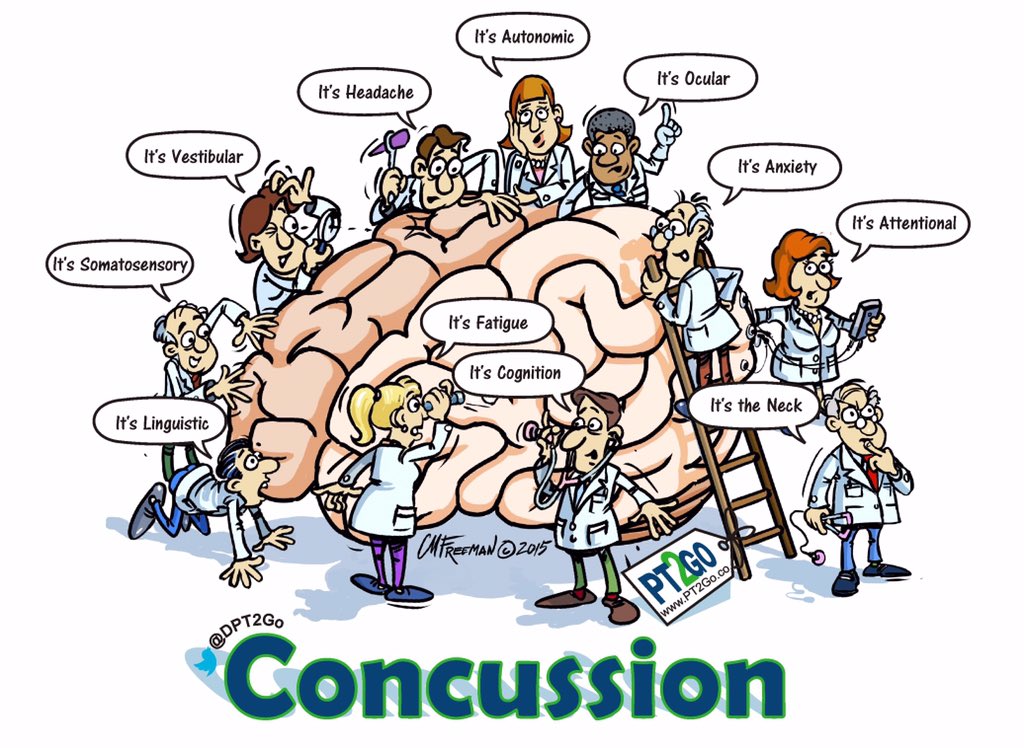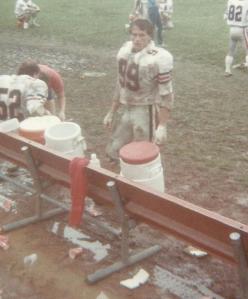 Sure, this is the fifth post of 2016 – and its July – however there is a good reason for it. I continue to be an on the field athletic trainer, I continue to educate on concussion, I continue to be active on Twitter but more importantly I am concentrating more on being a father and husband. Blogging ain’t easy, folks; let’s be honest the coverage of concussion has blossomed well since 2009 when this blog started.
Sure, this is the fifth post of 2016 – and its July – however there is a good reason for it. I continue to be an on the field athletic trainer, I continue to educate on concussion, I continue to be active on Twitter but more importantly I am concentrating more on being a father and husband. Blogging ain’t easy, folks; let’s be honest the coverage of concussion has blossomed well since 2009 when this blog started.
All of that being said, I am also in the process of gaining further education in concussion. This is not your typical education about the injury but right were my mantra for the past six years has been:
The injury of concussion is not the true problem; it is the mismanagement of this brain injury that is the real issue.
As noted in March I began the Evidence in Motion Concussion Management Course. This is a 34 week program that was designed to bring collaboration and current information to those that can impact the real problem of this injury, the clinicians.
We have arrived at the half way point in the program, marked by the weekend intensive course – which met in Chicago this past weekend. Many have wanted to know has it been worth it. The answer is unequivocally, YES.
Before I get to the hands on of the weekend let me recap the first half of the program. One word cannot do it justice but in our search for snippets of information and quick reaction, that one word could be “trailblazing”.
Previously I wrote about how the program was basically going in terms of mechanics and what we were doing at the time. Since then I have read more research (current), discussed, and most importantly learned how to better help those that have been concussed.
We finished the Therapeutic Neuroscience Education and moved into the specifics of the concussion and its management. We spent a week on each of the following parts of the concussion continuum:
- Emergency Department – evolution and how they view the injury
- Orthopedics – how concussion relates to bones and muscles (neck)
- Vestibular Rehab – not only the vestib system but really focusing on the eyes
- Adult/Migraines – a previously unthought of link/predisposition for concussion
- Vision Rehab – what I feel will be the next area of focus for recovery from concussion
- Neuropsych/Return to Learn – how we all fit together in these areas as clinicians
- Speech Language Pathology – unknown to me how these professionals can and will help
Those seven weeks, plus the last week of summary were probably the most challenging Continue reading
 The meeting at Georgetown University this past weekend was more than fruitful for this athletic trainer. I went in trying to get two things done: one, provide info to you the follower as best as possible and move along the discussion on female concussion and two, to learn something that is applicable to me as a “boot on the ground” athletic trainer.
The meeting at Georgetown University this past weekend was more than fruitful for this athletic trainer. I went in trying to get two things done: one, provide info to you the follower as best as possible and move along the discussion on female concussion and two, to learn something that is applicable to me as a “boot on the ground” athletic trainer.
 Last year while in Zürich I was approached by a group of people from the Cleveland Clinic and they had a poster they wanted to show me. It had numbers, graphs and pictures – your normal poster at a conference – but what caught my eye was an iPad strapped on the back of a patient that was measuring movement. I asked very basic questions and to be frank I was a bit overwhelmed at the entire company I was keeping in Zürich, so the poster was a blur.
Last year while in Zürich I was approached by a group of people from the Cleveland Clinic and they had a poster they wanted to show me. It had numbers, graphs and pictures – your normal poster at a conference – but what caught my eye was an iPad strapped on the back of a patient that was measuring movement. I asked very basic questions and to be frank I was a bit overwhelmed at the entire company I was keeping in Zürich, so the poster was a blur. Two important groups released information about concussions and youth recently. The Institute of Medicine recently released its
Two important groups released information about concussions and youth recently. The Institute of Medicine recently released its  Coming to a bookstore and TV near you today is “League of Denial” a book and documentary about one of the dirty little secrets the NFL has been avoiding for some time. Fortunately, I have been provided with advance copies of both; the
Coming to a bookstore and TV near you today is “League of Denial” a book and documentary about one of the dirty little secrets the NFL has been avoiding for some time. Fortunately, I have been provided with advance copies of both; the  Coming to a bookstore and TV near you tomorrow is “League of Denial” a book and documentary about one of the dirty little secrets the NFL has been avoiding for some time. Fortunately, I have been provided with advance copies of both; the
Coming to a bookstore and TV near you tomorrow is “League of Denial” a book and documentary about one of the dirty little secrets the NFL has been avoiding for some time. Fortunately, I have been provided with advance copies of both; the 
 As an athletic trainer – an opinionated one at that – I struggle with all the “bells-and-whistles” in this conundrum that is the concussion issue. If you have visited here or heard me speak you undoubtedly know that mismanagement of concussions is the true issue of this complex paradigm. Yes, we need to know when a concussion occurs to begin the process in the right direction; however, this can be accomplished by simply making sure you have a trained medical professional on hand when the need arises. Getting an athletic trainer to cover the most at risk sports at the most at risk times is a great start (and in the authors opinion is the only choice if you want to have collision sports). Short of that,
As an athletic trainer – an opinionated one at that – I struggle with all the “bells-and-whistles” in this conundrum that is the concussion issue. If you have visited here or heard me speak you undoubtedly know that mismanagement of concussions is the true issue of this complex paradigm. Yes, we need to know when a concussion occurs to begin the process in the right direction; however, this can be accomplished by simply making sure you have a trained medical professional on hand when the need arises. Getting an athletic trainer to cover the most at risk sports at the most at risk times is a great start (and in the authors opinion is the only choice if you want to have collision sports). Short of that,  A paramount review of concussions and their “long-term” effects has been published (or soon will) in
A paramount review of concussions and their “long-term” effects has been published (or soon will) in  If you all recall I went to Zurich in November to attend the “Concussion Conference”; mainly as an observer, but there was enough time and opportunity to impart my questions/knowledge as a practicing athletic trainer. Here are the links to
If you all recall I went to Zurich in November to attend the “Concussion Conference”; mainly as an observer, but there was enough time and opportunity to impart my questions/knowledge as a practicing athletic trainer. Here are the links to 

 Time is short on this, I understand, but I just was dropped a note about this symposium being held in Chicago. Once again yours truly has “commitments”, this time it is a wrestling dual tournament – where my services are needed more. Regardless, when I looked at the faculty list and the speaking topics my interest was piqued. BIG NOTE here it is only $25 for athletic trainers to attend ($60 for physicians).
Time is short on this, I understand, but I just was dropped a note about this symposium being held in Chicago. Once again yours truly has “commitments”, this time it is a wrestling dual tournament – where my services are needed more. Regardless, when I looked at the faculty list and the speaking topics my interest was piqued. BIG NOTE here it is only $25 for athletic trainers to attend ($60 for physicians). I received the following press release about a Concussion Symposium coming up in March. The faculty is not your “usual suspects” rather some very good and known people in the medical field. If you get the chance to head down to Texas for that Saturday I believe you will not be wasting your time or resources. I would love to make it, however I have a prior commitment; that being said someone take good notes for me.
I received the following press release about a Concussion Symposium coming up in March. The faculty is not your “usual suspects” rather some very good and known people in the medical field. If you get the chance to head down to Texas for that Saturday I believe you will not be wasting your time or resources. I would love to make it, however I have a prior commitment; that being said someone take good notes for me.
 Due out tomorrow, Tuesday, September 18th, is Dr. Robert Cantu’s most recent writing on brain trauma; more specifically the concussion and how it relates to the ‘kids’. Dr. Cantu is THE expert when it comes to concussions, heck his CV is so expansive it would take up like 7 pages on here. The man knows his stuff; collaborating with Mark Hyman I believe he has written a book that is worth the read for everyone interested in this topic. By writing this book they not only address the concussion issue but the “iceberg below the surface” the youth athletes and their care. Obviously the millions that partake in sport and recreation are not privy to the top of the line medical staffs that the professional and high college athletes have at their disposal.
Due out tomorrow, Tuesday, September 18th, is Dr. Robert Cantu’s most recent writing on brain trauma; more specifically the concussion and how it relates to the ‘kids’. Dr. Cantu is THE expert when it comes to concussions, heck his CV is so expansive it would take up like 7 pages on here. The man knows his stuff; collaborating with Mark Hyman I believe he has written a book that is worth the read for everyone interested in this topic. By writing this book they not only address the concussion issue but the “iceberg below the surface” the youth athletes and their care. Obviously the millions that partake in sport and recreation are not privy to the top of the line medical staffs that the professional and high college athletes have at their disposal.